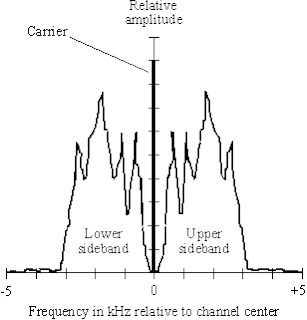Amplitude modulation (AM) is a method of impressing data onto an alternating-current (AC) carrier waveform.The highest frequency of the modulating data is normally less than 10 percent of the carrier frequency.The instantanous amplitude (overall signal power) varies depending on the instantaneous amplitude of the modulating data.
In AM, the carrier itself does not fluctuate in amplitude.Instead, the modulating data appears in the form of signal components at frequencies slightly higher and lower than that of the carrier.These components are called sidebands. The lower sideband (LSB) appears at frequencies below the carrier frequency; the upper sideband (USB) appears at frequencies above the carrier frequency.The LSB and USB are essentially "mirror images" of each other in a graph of signal amplitude versus frequency, as shown in the illustration.The sideband power accounts for the variations in the overall amplitude of the signal.
When a carrier is amplitude-modulated with a pure sine wave, up to 1/3 (33 percent) of the overall signal power is contained in the sidebands.The other 2/3 of the signal power is contained in the carrier, which does not contribute to the transfer of data.With a complex modulating signal such as voice, video, or music, the sidebands generally contain 20 to 25 percent of the overall signal power; thus the carrier consumes 75 to 80 percent of the power.This makes AM an inefficient mode.If an attempt is made to increase the modulating data input amplitude beyond these limits, the signal will become distorted, and will occupy a much greater bandwidth than it should.This is called overmodulation, and can result in interference to signals on nearby frequencies.
Sunday, May 3, 2009
Posted by M. USMAN SAJJAD at 1:54 AM
Subscribe to:
Post Comments (Atom)

0 comments:
Post a Comment